How to Design Packaging: Product Specs, Sustainability & Press-Ready Dielines
2025-09-13 11:14:36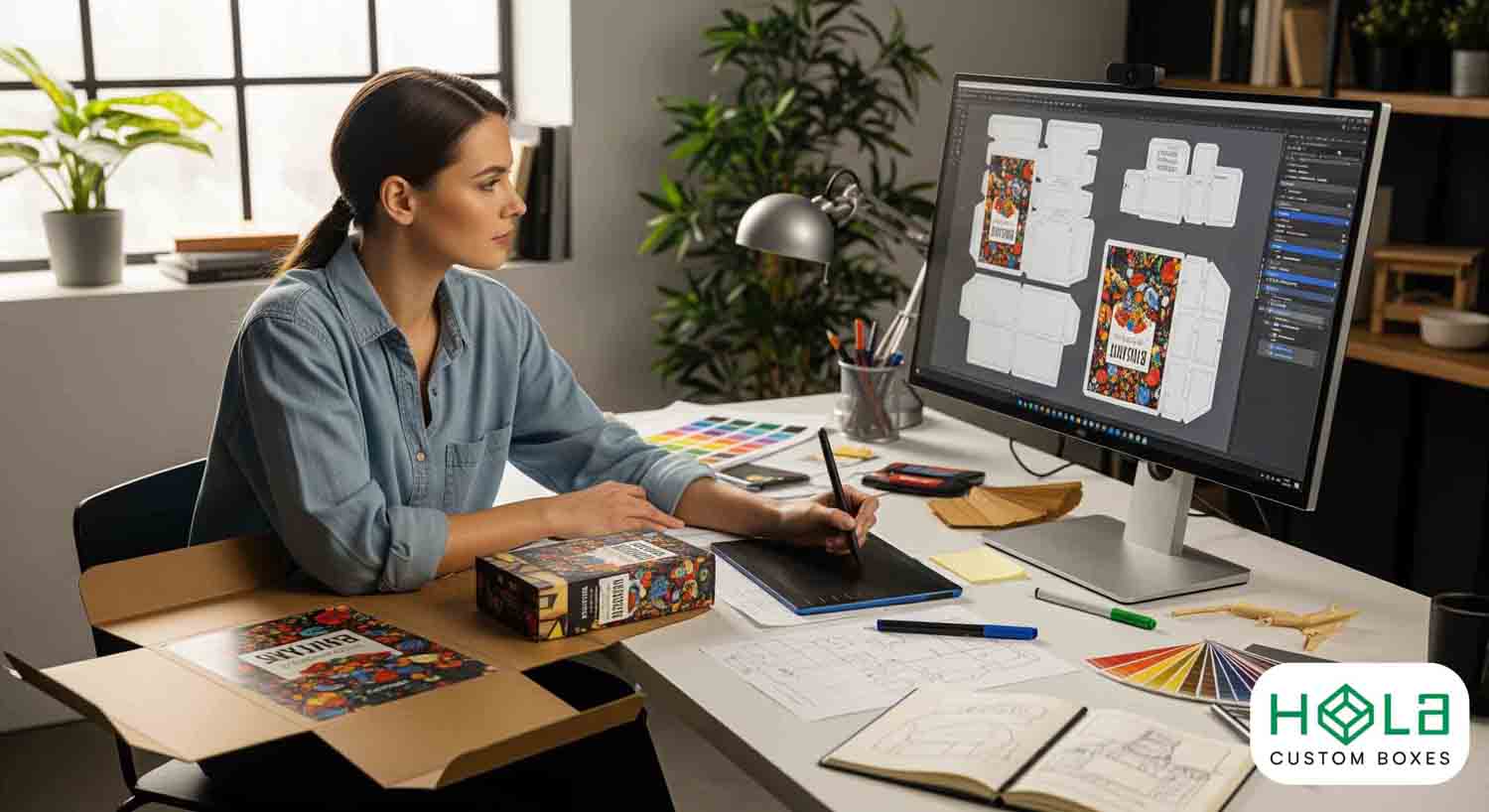
How to Design Packaging: Product Specs, Sustainability & Press-Ready Dielines
Start by measuring your product, noting materials and fragility, and mapping buyer needs and competitor cues.
Engineer a sustainable structure: mono-material, lightweight, recycled or plant-based, with clear recycling icons. Build visuals with a strict hierarchy—brand, product, key benefits—using two legible fonts, high contrast, and disciplined whitespace.
Prototype and stress-test; refine grip points, tears, and reveal. Then export press-ready dielines (CMYK/Pantone, bleeds, barcodes, legal marks).
You’ll find the full workflow, tests, and file specs next.
Main Points
- Research your product, target buyers, and competitors to define constraints, preferences, and differentiation opportunities.
- Engineer sustainable structures using lightweight, recyclable mono-materials; print clear recycling instructions.
- Establish visual hierarchy with legible typography, limited fonts, strong contrast, and a focused color palette.
- Prototype physical samples, then test durability and unboxing; observe users, gather feedback, and iterate quickly.
- Prepare print-ready dielines with correct bleeds, CMYK/Pantone specs, outlined fonts, barcodes, and legal marks within safety margins.
Research Your Product, Audience, and Competition
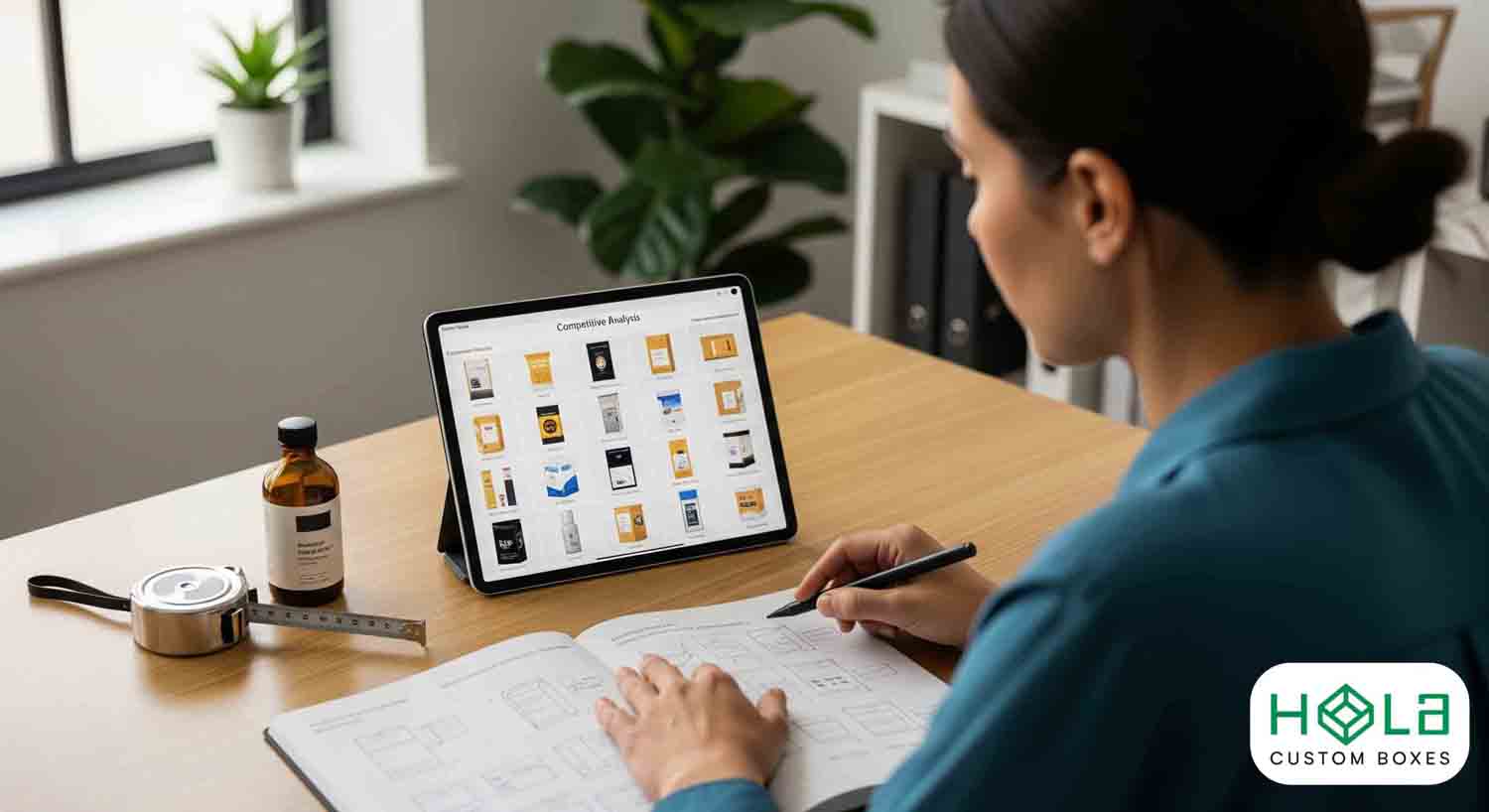
Before sketching concepts, map the essentials: document your product’s dimensions, materials, and fragility; define your target buyer by demographics, preferences, and purchase triggers; and audit competitors in-store and online.
Run research sprints: measure the product, simulate drops, and log constraints that drive the packaging design process.
Run sprints: measure dimensions, stress-test drops, and capture constraints that shape packaging decisions.
Profile the audience with segmented personas and buying contexts. Dissect competition for patterns, gaps, and market trends.
Mine customer feedback, reviews, and returns for pain points and desired visual appeal. Track social aesthetics to spark packaging ideas.
Translate findings into criteria that guide form, graphics, and messaging, leveraging design skills to prototype fast.
To align research with practical execution, note that custom fold-and-assemble boxes are cost-efficient and quick to produce, store, and transport, making them a strong option when prototyping and scaling packaging.
Start with dieline and structure; for shelf-ready work, browse retail packaging boxes.
Plan Structure and Materials With Sustainability in Mind
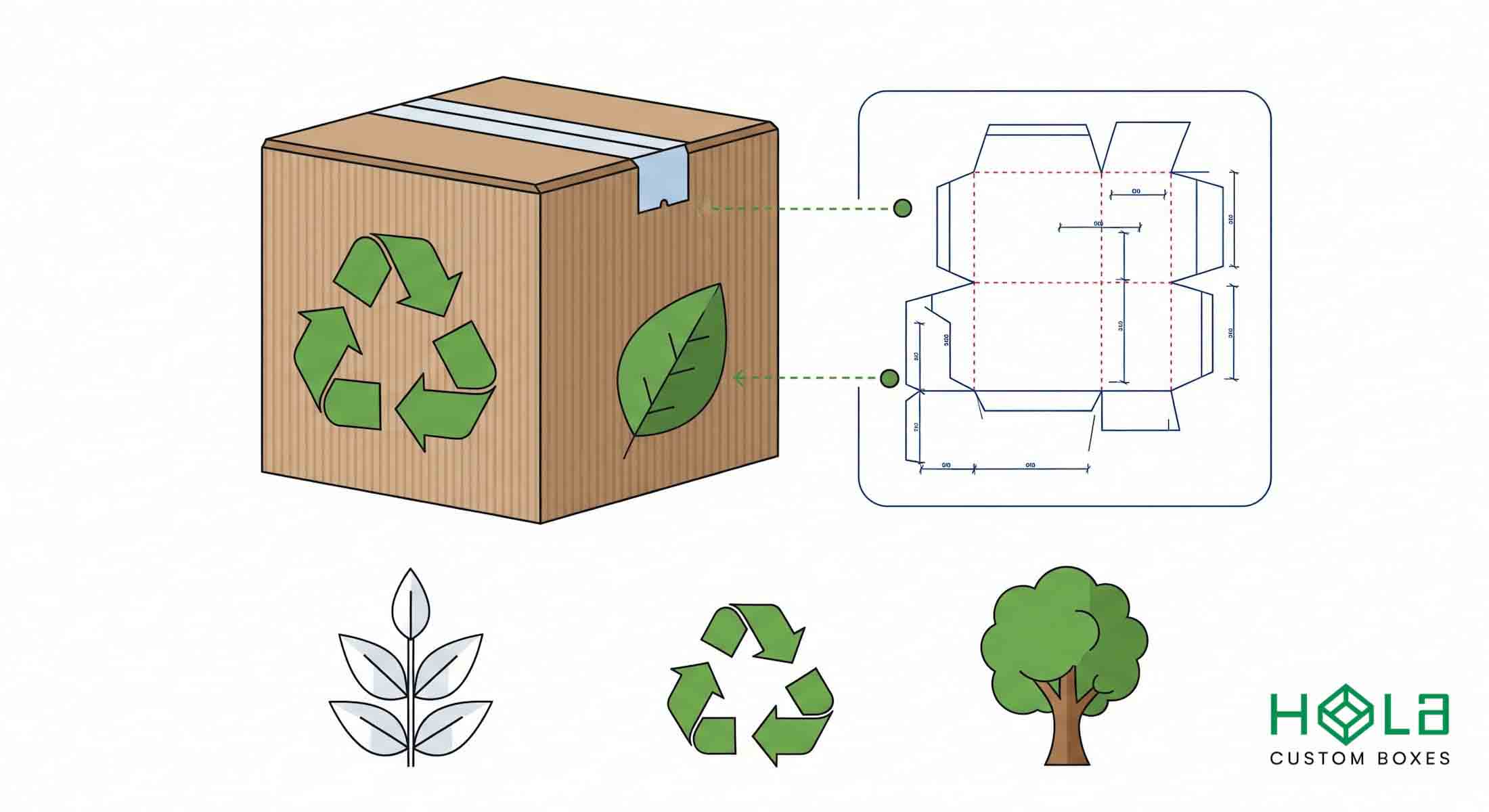
Although aesthetics matter, start by engineering a structure that meets sustainability targets without compromising protection.
Specify a packaging structure that uses biodegradable materials—plant-based plastics, recycled paper, or corrugated cardboard—to cut environmental impact while maintaining crush resistance.
Favor lightweight designs to reduce freight mass and emissions.
Eliminate mixed substrates so components are easy to recycle; use mono-material closures and minimal adhesives.
Print clear recycling instructions on primary panels.
Prototype reusable packaging with second-life utility.
Run life cycle assessments to compare materials and end-of-life scenarios.
Align choices with quantified sustainability goals, then validate through drop, compression, and humidity tests to guarantee performance.
Choose materials and formats that strengthen brand visibility while signaling sustainability, such as customizable eco-friendly boxes that are recyclable and made from lightweight, durable cardboard.
Eco goals? Print on custom kraft packaging boxes with soy inks.”
Develop Visuals: Hierarchy, Typography, and Color
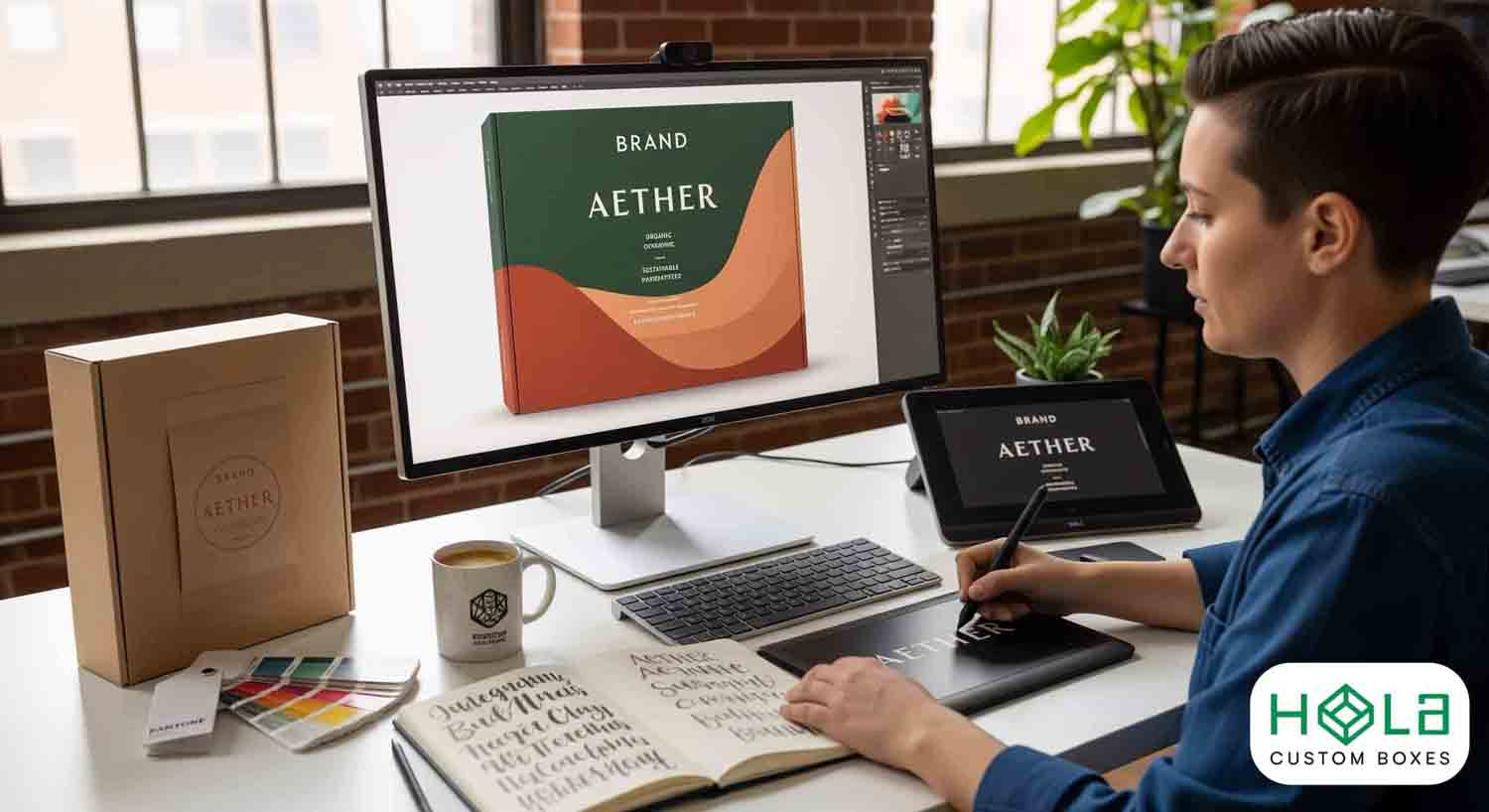
While structure protects the product, visuals win the glance: establish a clear hierarchy that prioritizes brand and product name at the top or center, then stage secondary info—benefits, size, claims—by importance.
Use scale, contrast, and white space to direct scanning. Choose typography that’s legible and on-brand; limit to two fonts with disciplined weights. Build a color palette that signals identity and emotion; apply high contrast for essential parts and accessibility.
Deploy consistent visual elements—icons, patterns, cues—across packaging designs to strengthen brand recognition. Keep clean lines and balanced margins. This design helps you create packaging that’s coherent, navigable, and instantly readable.
For added impact and sustainability, consider using eco-friendly materials with premium finishes like UV coating or embossing to align aesthetics with environmental responsibility.
Premium launches shine in custom rigid gift packaging boxes using foil or emboss.
Prototype, Test, and Iterate the Unboxing Experience
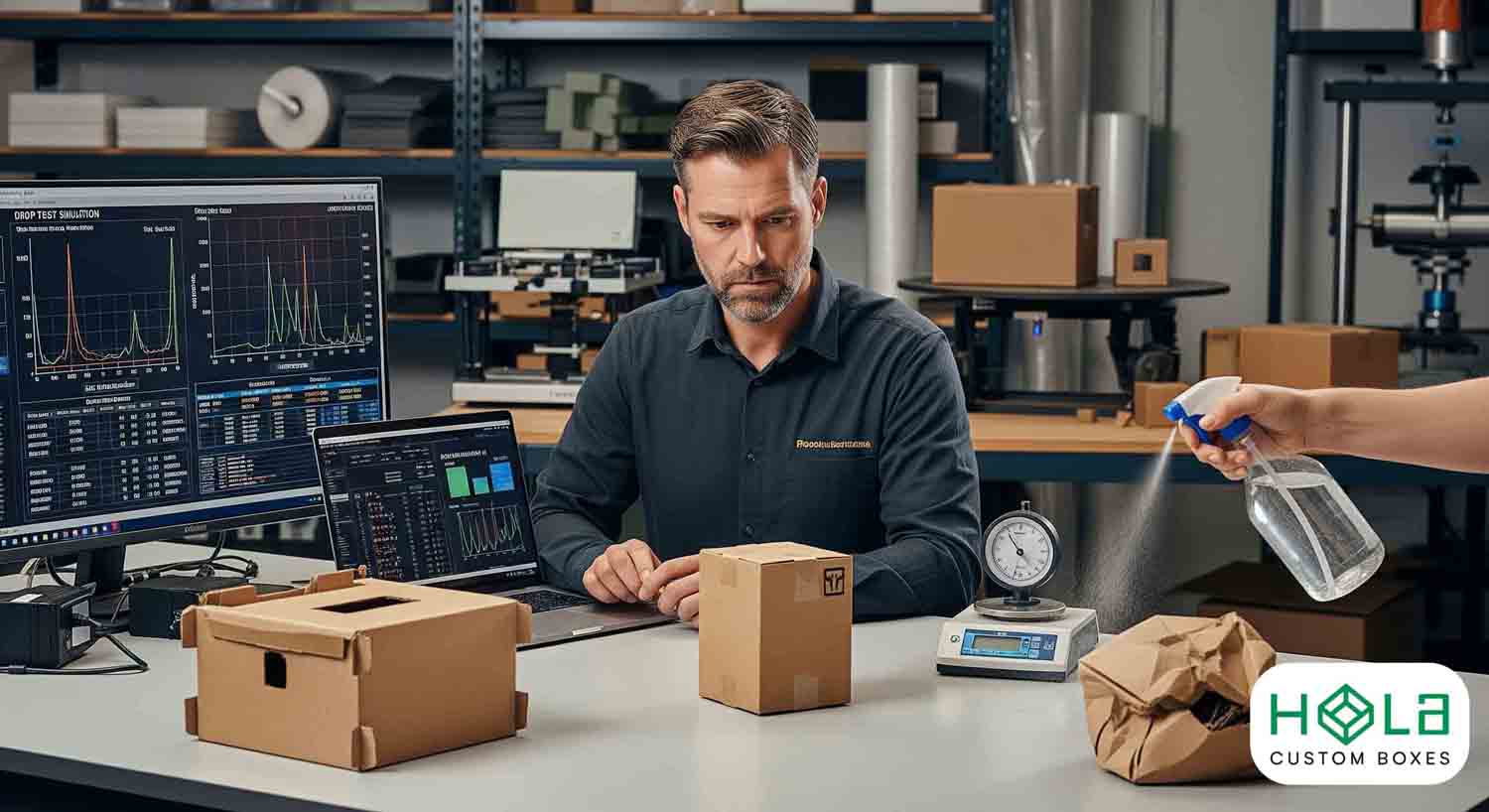
Blueprints become tangible in prototyping: build a physical mockup to validate structure, materials, closures, and print finishes, then run it through abuse.
Drop, crush, vibration, and moisture tests reveal weaknesses in functionality and packaging design. Record failure modes: torn seams, lid creep, ink scuff, cushioning bottoming out.
Stress-test packaging: drop, crush, vibrate, soak—then document failures from torn seams to cushioning bottom-out.
Observe the unboxing experience: grip points, tear direction, reveal timing, insert friction, waste volume.
Invite target users and run a timed test; capture feedback against customer expectations.
Fix pain points and iterate quickly: adjust dielines, swap substrates, tune adhesives, refine opening cues.
Repeat prototype cycles until protection, delight, and brand loyalty align.
Prepare Files for Print and Production
Your refined prototype now needs production-ready files that print exactly as intended. To prepare files for print, export clean vector files (AI, PDF) with outlined fonts and embedded images.
Build artwork on approved dieline templates; align panels, bleeds, folds, and glue areas precisely. Lock the dieline layer.
Set color specifications to CMYK or Pantone codes—never RGB—to guarantee accurate inks. Include product names, barcodes, and legal marks, placed within safety margins and scannable at print size.
Request a print spec sheet to match production standards: resolution, ink limits, overprint, trapping, varnish, white ink, and file naming.
Package assets and proofs to avoid delays.
Need help turning your concept into a dieline? See our retail packaging and rigid gift options.
Frequently Asked Questions
How Do I Design My Packaging?
You design your packaging by defining specs and audience, then mapping requirements to form, materials, and cost.
Audit competitors; extract size, structure, color, and messaging cues.
Sketch concepts; build dielines; prototype quickly. Use Illustrator/Photoshop; lock brand colors, type, hierarchy, and contrast.
Validate ergonomics, unboxing flow, and protection with drop tests. Iterate.
Choose recyclable or compostable substrates; optimize inks and finishes.
Prepare print-ready files with bleeds, CMYK, dieline, and varnish layers.
What Are the 4 C's of Packaging?
The 4 C’s of packaging are Customer, Cost, Convenience, and Communication.
You map your audience’s needs (Customer), balance materials and production budgets (Cost), optimize ergonomics—easy open, carry, store (Convenience), and encode clear visuals, claims, and instructions (Communication).
Use personas, costed BOMs, dielines, and usability tests. Prototype with recyclable substrates, legible typography, color contrast, and iconography.
Validate shelf impact with mockups and A/B tests; iterate to align value, price, and experience.
What Are the 7 Basic Steps to Packaging Design?
Define specs and audience; research competitors; map requirements (materials, protection, compliance, shipping/storage); craft a brief; ideate concepts (sketch/3D); prototype and test (fit, drop, seal, shelf impact, unboxing); iterate and finalize for production (dielines, BOM, print specs, sustainability).
You align visuals with function, choose substrates/finishes, validate costs, and guarantee logistics.
You’ll document guidelines, run pilots, and QA before rollout. Keep it modular, recyclable, and brand-consistent.
What Are the 5 P's of Packaging?
The 5 P’s of packaging are Product, Price, Place, Promotion, and People.
You align protection and shelf impact with Product. You balance material, tooling, and unit costs under Price.
You design for the channel under Place—stackability, ship tests, planogram fit. You use Promotion for brand cues, claims, and regulatory info.
You target People—user ergonomics, accessibility, and sustainability preferences. You prototype, test, and iterate to validate each P.
(Recommended Products)
